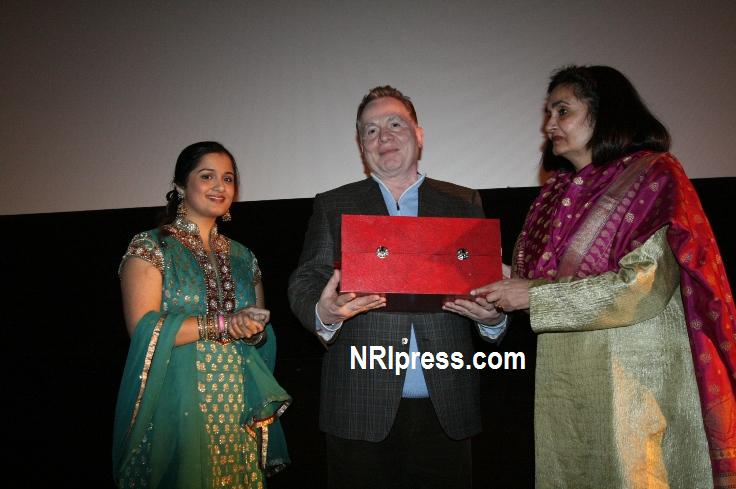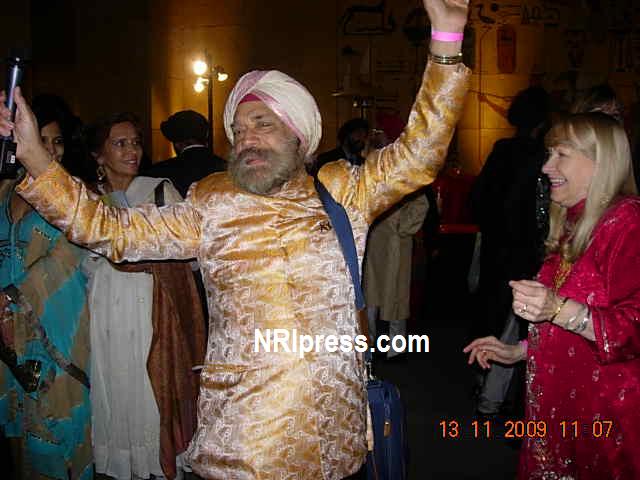Kanwal Prakash Singh
Indianapolis, Indiana USA
The Sikh Art and Film Festival (SAFF) sponsored by The SikhLens and Chapman University’s Dodge College of Film and Media Art, held at the historic Egyptian Theater in Hollywood, California, was an exciting festival of the arts, culture, and spirit (November13-15). The Festival provided some lasting images and new insights: the arts as a resource and powerful means to connect, illumine, and introduce the proud rich Sikh heritage and contributions to new global audiences; and dispel some unfounded stereotypes about Sikh faith, culture, and community.

HISTORIC COURTYARD AND NEW SPIRIT
The recently-restored Egyptian Theater offered a setting that resonated the theme of the 2010 Sikhpoint Calendar: ‘Conserving Sikh Heritage’ that celebrated the work of one of the honored guests, Architect Ms. Gurmeet Rai, who came from New Delhi to attend the Festival. The Theater courtyard was turned into a festive space much like a movie set: a red-carpet welcome for the guests, colorful cushions around tall palm trees as outdoor seating, light poles with fitted heaters to warm the guests against the November evening chill, sumptuous spread of North Indian dinner catered by Cuisine of India to delight the senses, prepared by of California, display galleries for paintings of Sikh heroes and scenes from Sikh history, and under the portico leading to the Theater, exquisite offerings of hand-crafted kirpans in crystal and metal, special books available for personal and corporate collections. The guests greeting and mingled just steps away from the famous Hollywood Boulevard’s sidewalk embedded with stars of Hollywood legends.
Hundreds of guests who attended the Opening Night Reception happily obliged the Gala Night’s
suggested dress code: Maharaja & Maharani attire, and arrived with elegant brocaded and jeweled dresses, regal achkans, colorful turbans with jeweled plumes, other festival accessories that added “Hollywood-Bollywood” glamour to the place and festivities. The familiar Egyptian hieroglyphics painted on the walls had some company, laser-projected SikhLens graphics on the walls and colorful Punjabi cultural textures and festive vibrancy in the courtyard. I am not aware of the nature of entertainment, dance, or music at the time of Egyptian Pharaos, but I cannot imagine that to be nearly as exuberant and liberating as the Bhangra dancing that followed the first set of films to the robust and lusty tunes of Punjabi folk-rock late into the night. We know that the Egyptian Kings were preoccupied with the afterlife, but the Maharaja and Maharanis this night had come with their hearty spirit and joyfully exuded the art of living Punjabi-style.
LEARNING, REMEMBRANCE, HISTORY, HERITAGE, LESSONS
Throughout the Art and Film Festival, multi-cultural and multi-generational audiences were introduced to the proud Sikh history, outstanding achievements, and contemporary challenges through films, books, panel discussions, and entertainment. The Festival attracted Sikhs and Americans friends from around the USA and abroad. Invited prominent and celebrated guests included: Architect Ms. Gurmeet Rai, Indian writer Ms. Jyoti Rai who co-authored with late Sardar Patwant Singh the book: Empire of the Sikhs ~ The Life and Times of Maharaja Ranjit Singh, from New Delhi; Ms. Mirin Kaur, Founder of The Kaur Foundation; Sardar and Mrs. Tejinder Bindra from New York. Also present were: from Canada, Ms. Jesse Kaur, a fascinating storyteller and author of her newly-launched book: The Royal Falcon; Ms. Navjot Kaur, author of a very interesting children’s book, A Lion’s Mane. The internationally renowned SinghTwins, Amrit and Rabindra, representatives of Maharaja Duleep Singh Trust and Anglo Sikh Heritage Trail came from U.K. All major and talented stars and filmmakers whose films were chosen for the various “Film Clusters” during the Festival, were recognized for their work with Heritage Awards by the Festival. The late Sardar Patwant Singh was also received a posthumous award in recognition of his lifetime of service and literary and philanthropic contributions to humanity; his award was accepted by Ms. Jyoti Rai.
The Sikh videographers, filmmakers, and their friends trained their lens to capture current and forgotten facets and facades of the Sikh history, heritage, and experience. Among the films that left a deep impression was ‘Nineteen Hundred Eighty-Four and Via Dolorosa Project’ by the SinghTwins. This film based on the painful events of June 1984 when the Indian army attacked the Golden Temple Amritsar and caused incalculable damage to the Sikh heritage and thousands of deaths was a testament of suffering in two distinctly different events in history. The moving narration in the film by the SinghTwins was as powerful as the images from the famous painting “1984” and historic film-footage of the fateful events of the Indian army’s assault on the holiest shrine of the Sikh faith and on a high holy day. Each word and each image brought home a thousand emotions. This deep scar, excruciating pain will not go away until all issues surrounding that dark period in independent India’s history have been honorably resolved. Thousands more who suffered indescribable horrors, humiliation, violations of sacred rights, and loss of loved ones later the same year in eighty cities across the India are still awaiting justice.
TURNING SCARS INTO STARS
As we reflect upon the tragic and unconscionable events of 1984, we must ask ourselves: what positive initiatives the Sikhs and world community need take towards bringing hope and healing to the Sikh nation over the ‘1984 anti-Sikh pogroms.’ With the digital technology available to us, can we restore any portion of the loss of some of the most sacred relics, documents, rarest books in the Sikh Reference Library in the Golden Temple complex that were destroyed during the Indian Army’s assault on the heart and soul of the Sikh faith? What steps must we take to safeguard and archive other priceless Sikh spiritual and cultural treasures from being lost forever due to neglect or acts of man-made or natural destruction?
The Festival and films, and hundreds of major events throughout the USA and abroad every year were answering that challenge. Other films that stood out included ‘Tubanology’ by Jay Singh-Sohal; ‘turBan,’ a music video about the ban of Sikh turban in France by Sartaj Singh Dhami; ‘The Holy Duel of Holla Mohalla’ at Anandpur Sahib; and thought provoking film about non-biodegradable waste in the Sikh temples across the world in the film, ‘Virtues Misinterpreted’ by Minu Singh. There were other interesting films, ‘My Mother India’ by Safina Uberoi of Australia, and ‘The Rebel Queen’ by Michael Singh of Los Angeles. Michael Singh served as the director of The Festival.
FRIENDS AND SPONSORS
The 2009 Art and Film Festival had many financial sponsors and friends including Anglo Sikh Heritage Trail, Cultural Resource Conservation Institute, The Kaur Foundation, The SinghTwins, Chapman University, and others. Several guests who attended some part of the Festival added their own spirit and excitement to its success. The one sevak and largest sponsor that needs special mention is Sardar Bicky Singh, CEO of Future Computing Solutions Inc. He as a major benefactor and guiding force shares his vision and deep commitment of celebrating Sikh culture with a quiet passion. Sardar Bicky and his wife Gurpreet welcomed each guest as they arrived for the Festival’s opening night Gala. Our congratulations to all who tirelessly work with him, made the 2009 Sikh Art and Film Festival another grand success.
PERSONAL REFLECTIONS
Such Festivals, gatherings, forums, and community engagements affirm that Sikh Americans are in search of a rightful place for their heritage, culture, and spirit in the new world, and maintaining strong ties with their past. They understand that they have to go beyond preaching to their own community. They are asking: where must such ‘festivals of culture and spirit’ lead us and how the lessons and ideas from such gatherings translate into more innovative and imaginative initiatives to advance our interests in the communities where we live and work?
This new-found vitality, creativity, passion, and use of new mediums and familiar venues by Sikhs to mainstream their celebrations is noteworthy and encouraging. We would not know the ripple effect of the landmark endeavors taking place throughout the Sikh world in Diaspora. We can be certain that the impact of such involvements and investments is significant, especially for our youth who are growing up far removed from the soil, history, and culture that shaped the lives and values of their parents and grandparents.
NETWORKING TOWARDS PROMISING IDEAS
As the daring new pioneers to this land, Sikh Americans need to share their culture, unique experiences, wisdom, and aspirations with others. We enhance our opportunities immeasurably when we see ourselves, as our children surely do, that we are a part of the larger tapestry of faiths, cultures and communities who came before us; when we make our identity as an integral part of our collective identity as Americans, as world citizens. We must recognize and seize the power of our common destiny rather than our separateness as an ethnic and religious minority. Going forward, we must work in solidarity, emphasize our shared universal values and work ethic, common hopes and dreams, and strengthen what binds our humanity; create opportunities for joint celebrations, join hands in special festivities and worthy service projects with other Americans. Combining our collective energies and talents in the pursuit of ideas and visions that generate trust, understanding, respect, and sense of belonging can be very rewarding and reassuring. Working with schools and universities, networking with business, faith, and community leaders, and civic engagement at many levels and in multiple ways is already opening new doors and providing amazing possibilities.
Perhaps in the not-too-distant-future we should also think about whether there is any merit in the East and West coast Sikh organizations occasionally planning joint celebrations, may be in America’s Heartland; build an outstanding interactive National Sikh Learning and Heritage Center on the lines of The Jewish Holocaust or Native American Museums in Washington, D.C. May be on the patterns of Kumbum Chamtse Ling Monastery (West) in Bloomington, Indiana. A Sikh National Hall of Fame that traces and celebrates our great past and present pioneers who have made outstanding contributions to the American Republic and the world community may be another idea on the horizon to explore.
The ideas that I mentioned are no bigger than our will to make them happen. By Sutguru’s Grace, all is possible. Many dedicated visionaries and philanthropists, some in spotlight and others quietly, are tirelessly working to set an example, especially for our youth to be dream- catchers and lead the next generation, and “be leaders for tomorrow today.” Let us remember the famous words of our elder marathon champion, Sardar Fauja Singh, “Impossible is nothing.” We know our spiritual and cultural foundation and our faith lessons and live among legends of great heroes who provide testimony of triumphs against formidable odds and making unimagined dreams into reality. They challenge us to fiercely compete in the Holla Mohallas of our time and reach for the impossible. Our forums, mediums, and gatherings are only a vehicle, the spirit that they evoke and passions that they generate can transform and move us in profound ways. I came away from The 2009 Sikh Art and Film Festival with a renewed sense of optimism and in search of my responsibility towards this end.
Click for more Articles:
 Kanwal Prakash Singh
Kanwal Prakash Singh
Indianapolis, Indiana USA